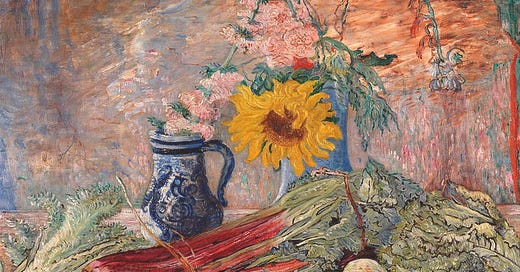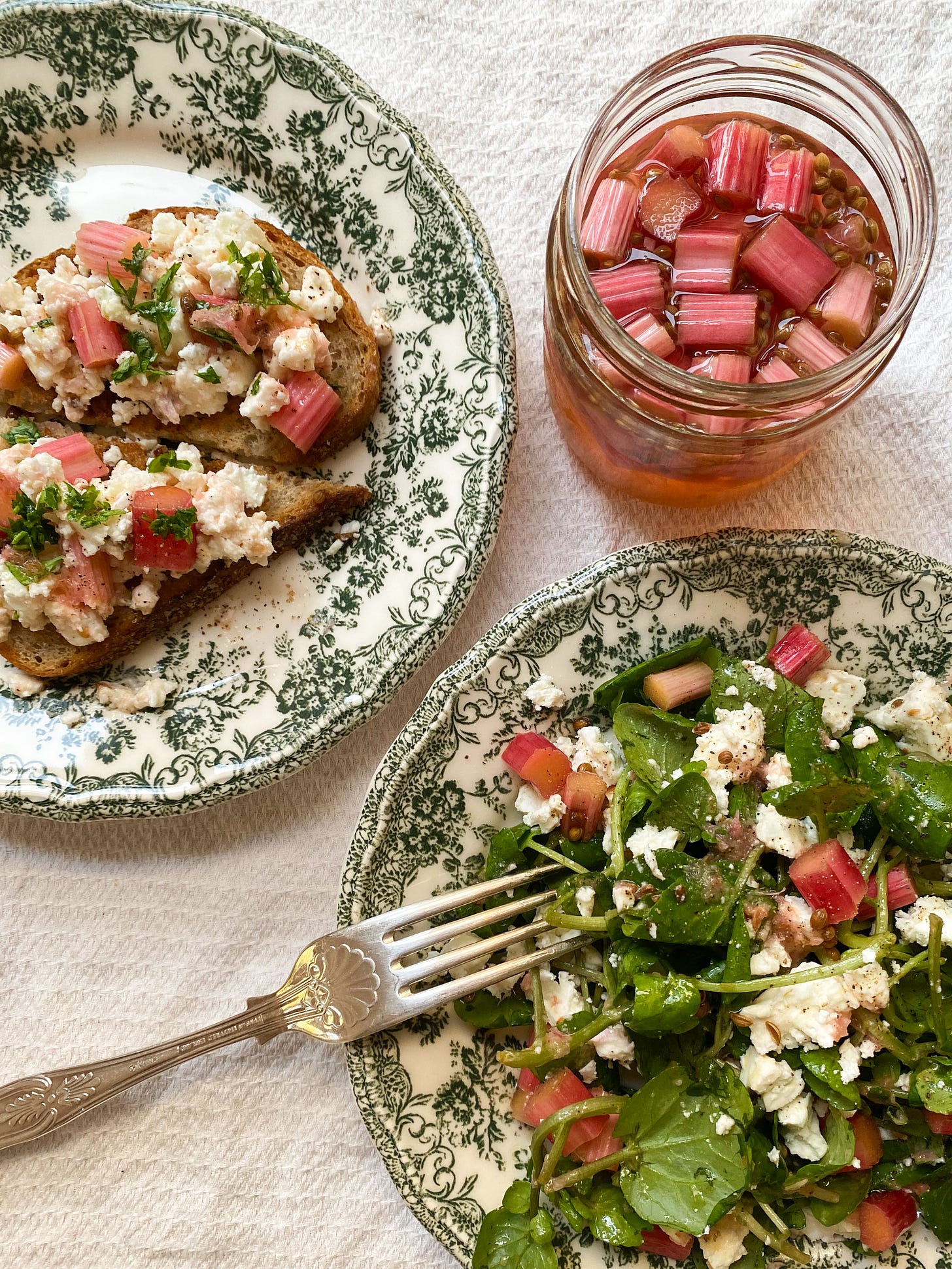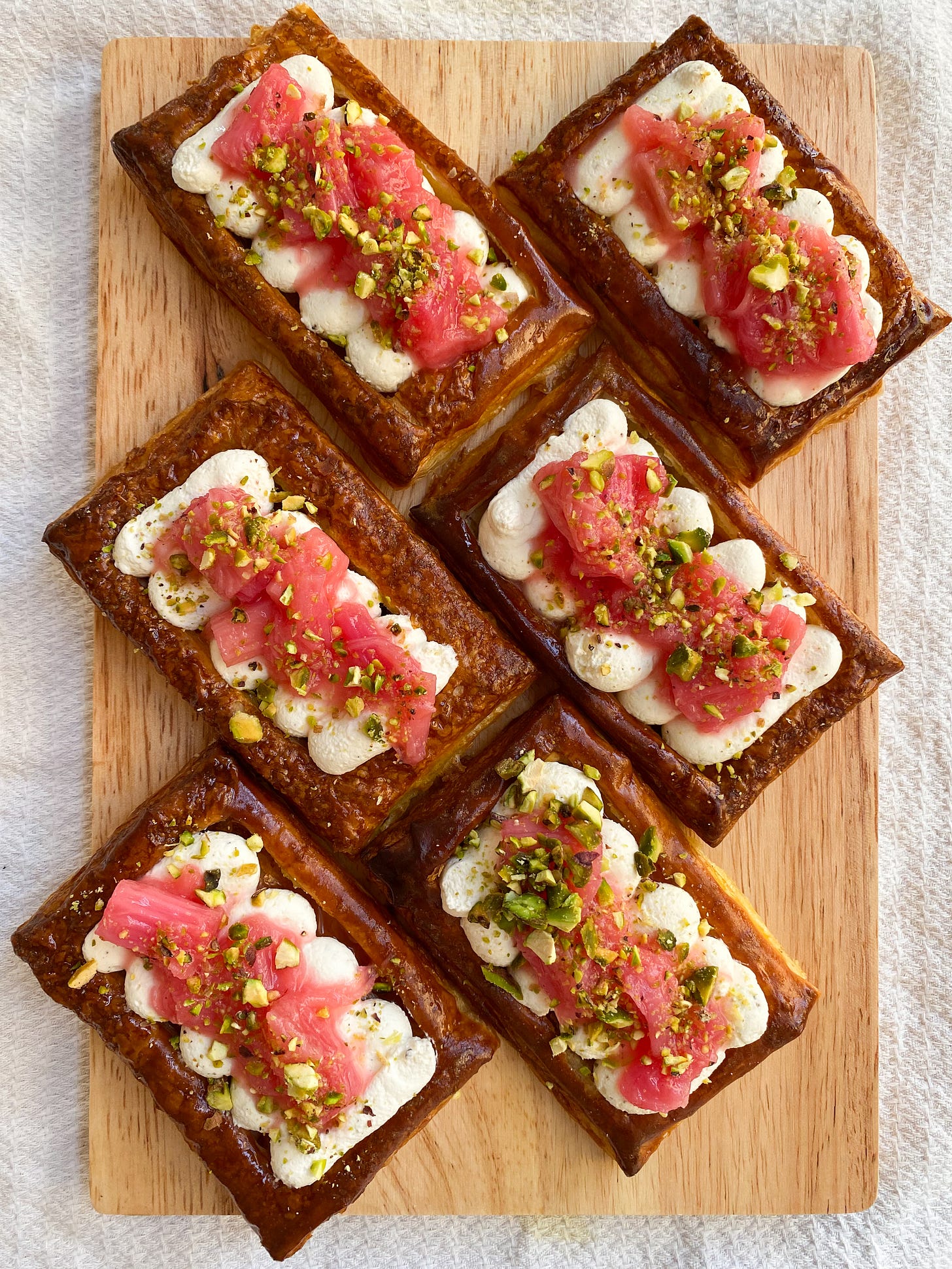Rhubarb; From Ancient Medicine to a Delicious Culinary Ingredient
Exploring the journey of rhubarb from an ancient medicine and folklore to its use as a culinary ingredient and food produce
It’s rhubarb season! The beautiful pink stalks of forced rhubarb (and greenish pink stalks of regular rhubarb) are a little sweet with such a punchy tart sourness making them a vegetable that is often used in desserts and baking. I have memories of my mum making rhubarb crumbles and a rhubarb and sour cream loaf cake, and as a kid I have to say it was my least favourite kind of crumble - however, over the years it has become one of my favourites, you just can’t get that sourness from anything else! In this newsletter I will explore the history and folklore of rhubarb like usual, but there will also be a bit about the health benefits of rhubarb from nutritionist Felicity Vincent so keep reading for that!
The rhubarb plant is native to Siberia, China and Mongolia because it typically does well in cold climates, so it is no wonder the earliest records of rhubarb are from China where it was often dried and ground into a powder and used as medicine, as a laxative. Rhubarb was mentioned in ‘The Divine Farmer’s Herb Root Classic’ a book written in the first-second centuries AD and attributed to the mythical Chinese ruler, and god of agriculture, Shennong, who tested and identified plants to use for medicine. The book itself is likely a compilation of oral traditions that had developed over time and were collated to be written down for the book, which sadly does not survive today.
Like many of the edible plants that I have been writing about rhubarb made its way along the Silk Road and arrived in Europe in the thirteenth century and likely to Britain by at least the 1500s as it is even mentioned by William Shakespeare in Macbeth.
“What rhubarb, senna or purgative drug, would scour these English hence?”
The way rhubarb is used here in Macbeth alludes to the fact that by this stage it was still only being used as a medicine and laxative. By this time rhubarb had actually become more expensive than Opium as the most popular medicine in the 1600s. Herbalist and botanist Nicolas Culpeper also wrote in his Culpeper’s Complete Herbal, a comprehensive analysis of the uses of herbs published in 1653, that rhubarb ‘strengthens the intestines’.
It wasn’t until the 1700-1800s, however, that rhubarb began to be used in cooking for eating. In 1817 some workmen threw soil over a patch of rhubarb roots at the Chelsea Physic Centre whilst digging in another area. This began the process of ‘forcing rhubarb’ because by accidentally depriving the roots of light, they found that the bright pink stalks grew providing a perfectly sweet and sour plant for eating. Once the process was refined rhubarb began being grown in the UK, particularly in West Yorkshire, in an area between Leeds, Wakefield and Bradford. This area was so prolific in their rhubarb production that it became known as ‘The Rhubarb Triangle’. There were around 200 rhubarb producers during this time (it is far less today) and there was even a train nicknamed ‘The Rhubarb Express’ that would transport all the freshly harvested rhubarb straight to Covent Garden Market in London for it to be sold.
With the popularity of rhubarb during this time it is no wonder that it became a source of folklore, as many plants do, and it was said in Cornwall that if a piece of rhubarb was worn as a necklace that it would ward off stomach cramps. This tradition likely came from the earlier medicinal uses for digestive health, but it seems the actual way of achieving said digestive health became a little misconstrued resulting in this interesting solution.
The rhubarb plant spread to Iran much earlier than it arrived in Europe, and has been growing on the land for so long that rhubarb even plays a key role in the Persian creation story. The ancient Persian mythology came to influence the religion Zoroastrianism and in a mythology centred on the push and pull of good and evil, it was told that the first mortal humans were born sprouting from rhubarb seeds. It still grows in Iran today and features in dishes like rhubarb lemonade and in savoury stews (which I would love to try).
I have tried to celebrate rhubarb with the recipes included here with some little pastries filled with cardamom cream, pistachios and of course stewed rhubarb, along with a cake that is perfect for a celebration birthday cake. Rhubarb is often used in sweet dishes so I have also included a really fun savoury recipe for pickled rhubarb, as that tartness lends itself really well to being pickled. Keep reading for the health benefits of rhubarb written by nutritionist Felicity Vincent, who also studied at Le Cordon Bleu and posts wonderful recipes along with her posts! Check out her Substack ‘Spoonful of Felicity’.
Health Benefits of Rhubarb by Felicity Vincent:
Is rhubarb good for me? Well, I don’t think any fruit or vegetable is a magical solution to one’s woes. But each of them do have their own set of unique compounds to support our body. They’re like superheroes who need to join the Avengers to work at their best. So what are rhubarb’s own unique set of powers?
Let’s start with its dark side: rhubarb contains oxalic acid meaning children should only consume small amounts and anyone suffering from renal stones should avoid it. The levels are toxic in the leaves, which therefore shouldn’t be eaten.
Now for the good stuff! The first thing to note is its pretty pink colour. This is due to anthocyanin, a pigment which acts as a polyphenol, meaning a potent antioxidant compound linked with lower risk of certain cancers and age-related diseases. Anthocyanins also act as anti-inflammatories, preventing brain damage, reducing memory loss and supporting cognitive function. Of course, forced rhubarb with its famously vibrant colour will have the highest anthocyanin content.
Secondly, rhubarb is a good source of vitamin K which is needed for wound healing, and bone health. Vitamin K is also required for the synthesis of sphingolipids, specific structural lipids which play an essential role in brain cell function, recent research has linked sphingolipid health with healthy aging and reduced risk of neurodegenerative disorders such as Alzheimer's and Parkinson’s.
Thirdly, rhubarb is known for its anthraquinone content. These compounds have been linked to anti-viral properties and promoting the immune system, but they also account for rhubarb’s long historical use as a constipation cure. Research now shows that these active compounds, when consumed in enough quantities that some is able to reach the lower intestine, can act as a laxative. It’s also worth noting that rhubarb is also high in fibre to support this cause. No wonder then that rhubarb has been used to that effect for over 2,000 years, being consumed only for medicinal purposes until the late 18th Century.
Finally, and most importantly, rhubarb supports our mental well-being, not only through it’s delicious addition to pies, crumbles and yogurt, but also through the role of anthocyanins on our dopamine receptors (a good-mood hormone) and the impact of its active compounds on our gut health. Always remember a happy gut means a happier brain.
Rhubarb Recipes:
Quick Pickled Rhubarb:
Rhubarb is so often used in sweet recipes, and rightly so because it is so delicious this way. But, it is a vegetable, and so it can hold up really well in savoury dishes. This recipe is for a quick pickled rhubarb (which has such an interesting flavour) which can then be used in salads, on toasts, I also turn it into a salad dressing here and it pairs really well with a salty cheese like feta.
Ingredients:
Pickled Rhubarb:
200ml apple cider vinegar
200g caster sugar
200ml water
20g salt
2tsp coriander seeds
200g rhubarb
Salad Dressing:
2tbsp pickled rhubarb
1tbsp pickled rhubarb brine
1/2 lemon juice
2tbsp extra virgin olive oil
2tsp maple syrup or honey
Salt and pepper
Method:
Place the apple cider vinegar, caster sugar, water, salt and coriander seeds (or whatever seeds you are using) into a pan and bring to the boil.
Turn down to a simmer and ensure that all the sugar and salt is dissolved. Take off the heat to cool down.
Cut your rhubarb into small slices approx 5cm across and place them inside a clean jar or container. Pour the brine liquid over the top.
Let them pickle in the fridge overnight and they are ready to enjoy and serve the next day!
As these are quick pickles they will keep for a few days and need to be kept in the fridge. However if you want to store them at room temp for longer, be sure to properly sterilise your jars and follow a canning recipe to ensure it is done correctly.
Once your pickles are ready you can make a lovely salad dressing by blending some pickled rhubarb with the brine, lemon juice, extra virgin olive oil, maple syrup or honey and salt and pepper to taste. Blend this up (I find a food processor works better than a blender but you could add a splash of water to help it along).
The salad dressing, along with a few pickled rhubarb pieces go great with peppery watercress and a salty cheese like feta. Perfect as a salad base or on toast. Serve and enjoy!
Rhubarb Pastries with Cardamom Cream and Pistachios (makes 10):
Rhubarb, cardamom and pistachios are the perfect flavour combination for me so these little pastries contain them all. I make life a little easier by using ready to roll puff pastry and then once your rhubarb has stewed and cream has whisked it is all about the assembly. These are great little treats to offer guests!
Ingredients:
Rhubarb:
200g rhubarb
60g caster sugar
1/2 lemon juice and zest
15ml water
320g puff pastry (I used Jus-Rol ready rolled puff pastry sheet, but you can use homemade also)
1 egg
300ml double cream
12 green cardamom pods (or 1tsp ground cardamom)
20g pistachios
Method:
Cut the rhubarb into small chunks, around 5-10cm big. In a pan add the rhubarb, the caster sugar, lemon juice and zest and water.
Bring the mix to a boil, once it has come to a boil immediately turn down to a low simmer.
Cook for only a couple of mins until the rhubarb is starting to cook. You want the rhubarb to maintain its shape, so as soon as it starts to soften turn the heat off.
Place the mixture into a bowl (it will soften slightly more in the bowl from the residual heat).
Cool down and place in the fridge overnight. It is ready to use straight away, but if you leave it in the fridge overnight it will be an even brighter pink colour!
Preheat the oven at 180’C (160’C fan oven). Roll out your puff pastry (ensure it is room temp and not straight from the fridge). Cut into 10 slices.
With a knife gently cut an indent along all four sides of the puff pastry slice, about 2cm away from the edge. Be careful not to cut all the way through the pastry.
Place the pastry slices onto a parchment lined baking tray and bake for 20mins (or according to packet instructions). Set your timer however for half way, 10mins. Whisk an egg and brush over the pastry at this point. Then bake for the remaining 10mins. (This will ensure it will go golden brown without disrupting the rise of the puff pastry).
Once the pastry come out of the oven let it cool completely. With the back of a fork press down the middle section that has risen. Tip over and gently knock out the centre crumbs.
Meanwhile whisk the double cream with the cardamom until just about firm. If you are using cardamom pods grind these in a pestle and mortar or spice grinder. Place into a piping bag with a nozzle at the bottom and then into fridge for a few minutes.
Pipe the cream into your pastries in a swirling motion. (You could also spoon some in and smooth it out with a knife).
Spoon a little of the rhubarb mixture over each pastry.
Finely chop your pistachios and sprinkle over the top. Serve and enjoy!
TIP: If you think your rhubarb is a little over cooked and you want to stop the cooking process quickly. Place it into a bowl. Then place some ice cubes and a splash of water into another bowl. Place the bowl with rhubarb over the top and very gently mix until the rhubarb has cooled completely. Now pop in the fridge.
Rhubarb and Sour Cream Cake:
This cake was inspired by my Nans love for rhubarb, and I made it for her 93rd birthday recently. My mum has made a delicious rhubarb and sour cream loaf cake in the past using the regular green-pink rhubarb which kind of inspired this cake, but I wanted to use forced rhubarb for that wonderful pink colour and it is a little less tart. Sour rhubarb and sour cream might seem like a strange combo but they work really well together when paired with the right amount of sweetness (so warning this isn’t a low sugar recipe). It is such a fun celebration cake - perfect for any event!
Ingredients:
Rhubarb:
800g rhubarb
1/2 lemon juice
200g caster sugar
6tbsp water
Cake:
250g butter
360g caster sugar
4 eggs
360g flour
2 tsp vanilla bean paste (or extract)
2 tsp baking powder
200g sour cream
Icing:
600g double cream
150g sour cream
50g icing sugar
1tsp vanilla paste
Method:
Cut the rhubarb into inch pieces. Place into a pan with the lemon juice, caster sugar and water.
Bring the mix to a boil, once it has come to a boil immediately turn down to a low simmer.
Cook for only a couple of mins until the rhubarb is starting to cook. You want the rhubarb to maintain its shape, so as soon as it starts to soften turn the heat off.
Place the mixture into a bowl (it will soften slightly more in the bowl from the residual heat).
Cool down and place in the fridge overnight. It is ready to use straight away, but if you leave it in the fridge overnight it will be an even brighter pink colour!
Preheat the oven at 200’C (or 180’C fan oven).
For the cake place the room temperature butter and sugar into a bowl or stand mix and cream beat until smooth, pale and fluffy.
Gently whisk in the eggs next, one by one.
Next sift in the plain flour and gently fold into the mixture.
Add the vanilla paste and baking powder and stir into the mixture.
Lastly gently fold in the sour cream.
Line the base of two 23cm baking tins with butter and parchment. Grease the whole tin with butter and then cut a circle of parchment for the bottom of the tins.
Place the mixture evenly into each tin. Give the tin a little tap on a counter to even out the mixture.
Place into the oven and bake for about 30mins or until a toothpick comes out clean when inserted into the centre of the cake (this could take up to 40mins, check your cake every 5 mins if the toothpick does not come out clean to begin with).
Place the cakes onto a wire rack and allow to cool completely.
Meanwhile whisk the double cream, sour cream, icing sugar and vanilla paste together until you get a stiff texture but be careful not to over whisk. I recommend using a stand mixer or an electric whisk.
Once the cakes are cool, place half the cream into a piping bag and pipe a big line around the edge of one of the cakes. Then pipe a swirl all the way around the inside.
Take about a third of the rhubarb mixture and place in between the cream lines.
With the rest of the cream smear it over the top of the other cake. Once its even take a spoon and create a kind of divot in the centre in a swirl like motion. Place the remaining rhubarb in the centre.
Sandwich the cake together and then serve and enjoy!
TIP: When making cakes that say to use a teaspoon of baking powder make sure you are using a proper teaspoon measurement. Cutlery ‘teaspoons’ are actually made in varying sizes and so you will not get the exact amount needed every time.
If you read this piece or make one of the recipes - thank you! Right now I am just trying to write about a few things that I find interesting. I am both a restaurant and private chef so I am always coming up with and developing recipies and wanted to share them somewhere. I would love to get into food writing some more, so why not start here!











So beautiful and pink, that cake makes me excited for Spring!!
This was such a a worthwhile read!